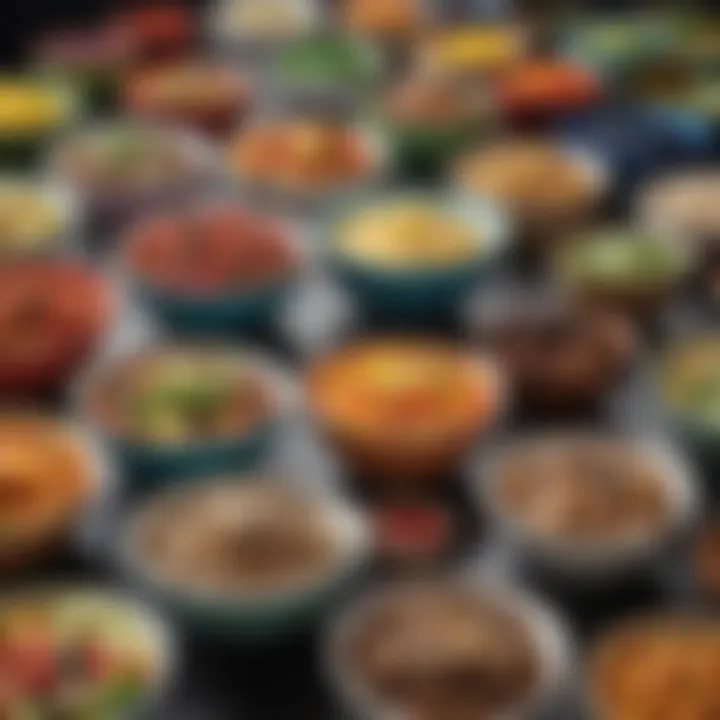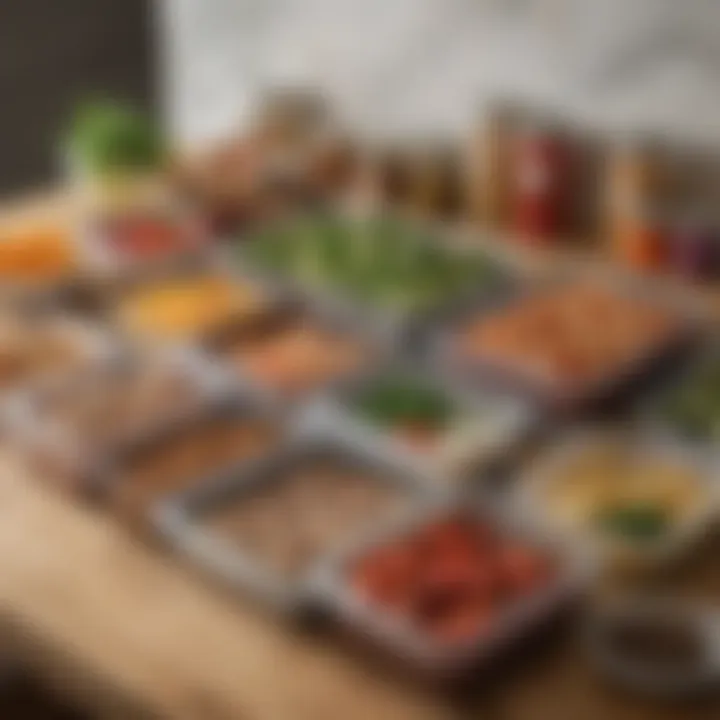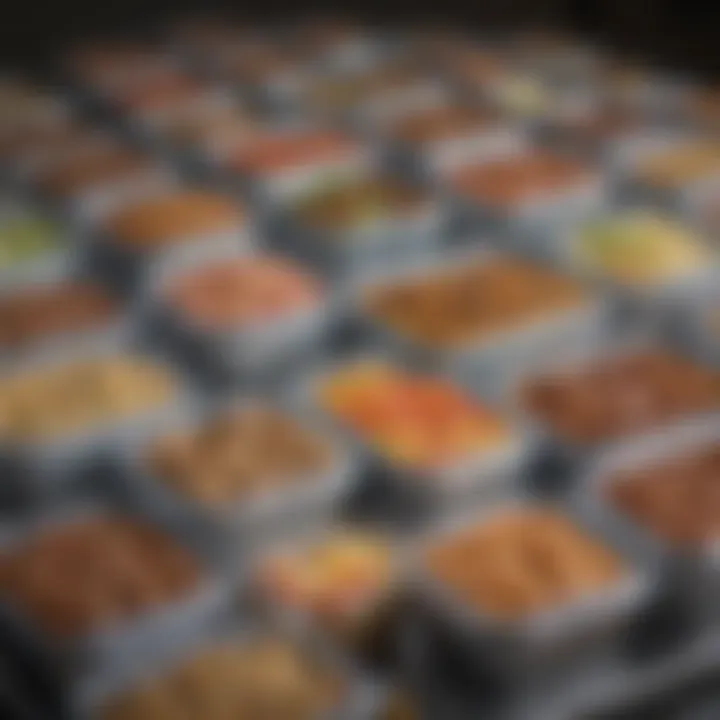Effective Meal Prep Strategies for 300-Calorie Dishes


Intro
Meal prepping is a systematic approach designed to ensure health conscious diners can swiftly access flavorful meals, ideally suited for busy lifestyles. The art often involves balancing nutritional needs while ensuring portion sizes remain within specific calorie limits. This segment of the article encourages home cooks to explore an effective method to prepare 300-calorie dishes that satisfy hunger without compromising on taste.
Understanding the significance of meal prepping enhances one’s dietary control, providing visibility into food choices and ingredient applications. Notably, this guide aims to underscore useful strategies, leveraging pantry staples and varied culinary techniques to create diverse meals. The following sections present enticing recipes laden with nutritional value, insights on ingredient selection, and helpful tips for seamless preparation.
Recipe Highlight
Introducing the Zesty Chickpea Salad—a vibrant mix designed specifically to pack a nutritional punch within a 300-calorie allowance.
Essential Ingredients:
- 1 can of chickpeas, drained and rinsed
- 1 medium cucumber, diced
- 1 cup cherry tomatoes, halved
- 1/4 red onion, finely chopped
- 2 tablespoons lemon juice
- 1 tablespoon olive oil
- 1/4 teaspoon smoked paprika
- Salt and pepper to taste
Estimated Time:
Prep time of just 15 minutes
Servings:
This recipe yields 4 servings.
Step-by-Step Instructions
- In a large bowl, combine the chickpeas, cucumbers, cherry tomatoes, and red onion.
- In a small bowl, whisk together lemon juice, olive oil, smoked paprika, salt, and pepper.
- Pour the dressing over the chickpea mixture and toss well to coat all ingredients evenly.
- Let the salad sit for about 10 minutes to ensure that flavors meld before serving.
Cooking Tips: Ensure that all ingredients are chopped evenly for balance in each serving. Avoid over-mixing to prevent the vegetables from becoming mushy. Taking these small steps in preparation ensures your salad maintains its integrity.
Variations and Substitutions
For those looking to enhance or adjust this recipe:
- Add proteins: grilled chicken or quinoa can serve as excellent complements.
- Swap ingredients: Consider using black beans instead of chickpeas or switch the cucumber for bell peppers for a unique taste.
- Add herbs like parsley or cilantro for added freshness.
Flavor Additions: A sprinkle of feta cheese or avocado slices elevates the dish, both in richness and presentation. Pairing with whole-grain pita can round off the meal beautifully.
Time-Saving Cooking Tips
Efficient meal prep requires planning:
- Chop ahead: Set aside time during the week to chop all required veggies and store them in airtight containers.
- Organized ingredients: Keep commonly used items visible and accessible in the kitchen. Tools such as a mandoline slicer can greatly hasten the slicing process.
- Batch preparation: Consider quiqly making multiple salads or dishes at once. This method works effectively in utilizing cooking efforts.
Nutritional Information
For the Zesty Chickpea Salad:
- Calories: Approximately 300 per serving.
- Key Nutrients: Provides a healthy dose of fiber, protein from chickpeas, healthy fats from olive oil, and rich vitamins from varied vegetables.
- Diet Suitability: This meal fits various dietary plans, being suitable for vegans and gluten-free diets.
This exploration of meal prepping focused on dishing up delectable 300-calorie meals aims to motivate readers to cultivate nutritional habits efficiently. Adjustments and experimenting with flavors empower individual creativity, adding to one’s culinary toolkit.
Understanding Meal Prep
Meal prep is more than just a time-saving tactic; it is essential for managing a healthy lifestyle in today’s fast-paced world. As we look deeper into this concept, several important aspects arise.
Defining Meal Prep
Meal prep refers to the practice of planning and preparing meals in advance. It involves both cooking and packaging meals that aligns with specific dietary preferences. This can include preparing full meals or simply washing, cutting, and storing ingredients for easy assembling. The method aims to optimize time spent in the kitchen while ensuring you have nutritious meals readily available.
In its essence, meal prep not only supports better eating habits but also allows for cost-saving by reducing the impulse to buy pre-packaged or fast food options. By allocating one or two days each week for meal preparation, individuals can maintain their health goals more effectively.
Benefits of Meal Prep
Understanding the benefits of meal prepping can enhance its adoption into daily life. Notably, there are several significant advantages:
- Time Efficiency: Once meals are prepared, daily cooking time is vastly reduced. Having meals packed away makes it easier to skip the cooking stress during busy days.
- Portion Control: Preparing meals in advance aids in managing portion sizes. Creating 300-calorie meals ensures intentional calorie intake, thus supporting any weight management goals efficiently.
- Nutritional Awareness: The process of selecting ingredients inherently promotes mindfulness about what goes into each meal. This knowledge can lead to healthier choices.
- Cost-Effectiveness: Preparing meals at home typically costs less than eating out or buying premade options.
- Variety and Creativity: Engaging in meal prep gives the freedom to try new recipes. This action curbs monotony and allows for culinary exploration.
Meal prep transforms the challenge of eating healthy into a more sustainable and enjoyable process.
The 300-Calorie Meal Framework
The 300-calorie meal framework provides a strategic way to streamline meal prepping while ensuring good nutritional quality and satisfaction. By focusing on the 300-calorie standard, you promote portion control effectively. This specific framework allows for individualized meal planning that fits into the restrictions of busy lifestyles without sacrificing health. Save time and effort spent on caloric considerations by integrating dishes into this structured format.
Maintaining a diet relevant to caloric density can directly influence effectiveness in weight management. Understanding what a 300-calorie meal entails prepares you for thoughtful planning and thoughtful eating. This can enhance energy, convenience, and enjoyment.


Nutritional Guidelines
It is crucial to grasp some nutritional guidelines to formulate effective 300-calorie meals. These guidelines help in selecting the right ingredients and ensuring adequate nutrition.
- Caloric Limits: Each meal should cap at 300 calories.
- Include Vegetables: Incorporate a variety of vegetables, concentrating on leafy greens, cruciferous varieties, or other fiber-rich options.
- Stay Hydrated: Eating 300-calorie meals can be complemented with water, herbal teas, or light broths, but avoid high-calorie beverages.
- Mindful Seasoning: Use spices and herbs for flavor instead of high-calorie sauces. This maintains the caloric limit without sacrificing taste.
This attention to detail not only constructs meals that fit into caloric limits but also cultivates awareness around dietary health.
Balancing Macronutrients
Equally as important to calorie counts are the macronutrients found within your meals. Striving for a balanced approach to carbohydrates, proteins, and fats is essential for ensuring optimal health and satiety.
- Proteins: They play a vital role in muscle repair and growth. Aim to include lean proteins like chicken breast, tofu, or beans that are efficient sources for your 300-calorie targets.
- Carbohydrates: Choose complex carbohydrates for energy. Whole grains, legumes, and starchy vegetables fulfill this role while maintaining the required caloric content.
- Fats: Healthy sources of fat, such as avocados, olive oil, and nuts provide necessary energy density within your meals. Remember to keep portion sizes in check.
This tripartite balance is essential not only for achieving energy levels but for overall well-being. Ensuring inclusion of each macronutrient category transforms a basic meal into a more symbiotic eating experience. An understanding of how these nutrients work together is a cornerstone of successful meal prep in the 300-calorie framework.
Essential Ingredients for Meal Prep
When it comes to meal prepping, selecting the right ingredients is crucial. The essential ingredients play a vital role in the flavor, nutritional value, and overall appeal of your meals. For 300-calorie dishes, considering certain factors in your ingredient choices is paramount. The focus should be on quality, variety, and how they contribute to creating balanced meals.
Using fresh, whole foods can make a significant difference in how your meal prep experience goes. Every ingredient you select not only translates to better health but also enhances the satisfaction of each meal. Key ingredients across three categories—proteins, carbohydrates, and healthy fats—can harmonize together to create delightful meals that are not just nutritious but also filling. This goes a long way toward sustaining energy levels throughout the day.
Protein Sources
Proteins are the building blocks of any meal preparation. They are essential in meal prepping for promoting satiety and supporting muscle health. Several options available can fit into this framework effortlessly.
Consider including foods like chicken breast, which provide lean protein with low calories. Tofu makes a great plant-based alternative, suitable for both vegetarians and vegans. Examples include traditionally prepared tempeh or even canned tuna for quick meal ideas. These sources tend to blend well into different meal types, be it savory or even in salads.
The key is to vary the protein types every week. This oscillation prevents the monotony of consuming the same ingredient repeatedly, which may detract from your meal prep enthusiasm.
Carbohydrate Options
Carbohydrates serve as another essential element in meal prepping, particularly for providing energy. They must be thought of critically in regard to both type and quantity. Favor whole grains over refined options for a wider range of nutrients.
Brown rice, quinoa, or barley are superb options you can incorporate to present alongside proteins. Starchy vegetables such as sweet potatoes or butternut squash can add depth and flavor to your dishes while maintaining that calorie count below 300. Additionally, cannelini beans or chickpeas can not only provide carbohydrates but also contribute valuable fiber.
Take this chance to experiment with different grains or carbs every week to maintain a diverse and balanced diet.
Healthy Fats
Healthy fats, while often skipped in low-calorie meal prep discussions, are essential. They assist in nutrient absorption and can enhance the flavor profile of your dishes. However, moderation is the key here, particularly when aiming to keep the meals within 300 calories.
Ingredients like avocados, olive oil, or even nuts such as almonds deliver the type of fat necessary without overwhelming your daily intake. Such options can be included beautifully, whether drizzled on a salad or used to sauté proteins to improve taste.
Ultimately, having an array of color and variation across ingredients will lead to comprehensive meals that do not feel restricting.
Consistent focus on quality ingredients fosters both healthy eating habits and culinary creativity in meal prepping.
Balancing these essential ingredients allows for thoughtful meal prep that can empower back-to-back cooking days and empower healthy choices without feel like you are depriving yourself. Ultimately staying committed to diverse, nourishing ingredients will bring satisfaction to your meal prep endeavors.
Efficient Meal Prep Techniques
Efficient meal prep is essential for anyone looking to maintain a balanced diet, especially with dietary goals centered around 300-calorie meals. These techniques streamline the cooking process, reducing time spent in the kitchen while enhancing organization and productivity. By implementing smart prep strategies, one can ensure that all meals do not solely meet caloric needs but are also varied and appealing.
Considering that many people operate on busy schedules, learning efficient prep can lead to stress reduction. Efficient meal prep tackles the challenge of planning meals ahead of time. It safeguards against impulsive food choices which may compromise health intentions. Having readily available meals encourages consistent commitment to a nutritious diet, providing easier access to healthy options at the end of the day. Investing effort into planning and preparation sets proper expectations for portions as well, ensuring that meals stay aligned with 300-calorie limitations.
Batch Cooking Essentials
Batch cooking is a cornerstone of meal prep. The concept revolves around preparing large quantities of staple ingredients or entire meals at once, then dividing them into smaller portions for future use. This approach not only saves time but reduces food waste and energy costs.
- Planning Your Menu: Before getting started,it's essential to decide what meals will be cooked. Selecting recipes that share similar ingredients aids in both shopping and prepping, maximizing efficiency.
- Cook Smart: Use methods like stovetop boiling, roasting vegetables, or grilling proteins simultaneously. Different dishes can share the oven or stovetop, optimizing cook time.
- Divide and Store: Once cooked, let the portions cool. Use proper storage containers for refrigerator or freezer. Label them with the contents and date to monitor freshness.
- Reheat Wisely: Consider different reheating methods to preserve texture and flavors. Do this while paying attention to portion sizes to stay within calorie limits.
Batch cooking empowers cooks to enjoy a diversity of meals all week long without continuous cooking.
Using Kitchen Tools
Having the right kitchen tools can significantly increase the efficiency of meal prep. Investing in useful gadgets not only simplifies tasks but also saves on time.
- Food Processor: Essential for chopping vegetables rapidly, a food processor can instantly turn various ingredients into meal-ready forms.
- Slow Cooker: The slow cooker is ideal for preparing protein-rich meals with minimal active cooking. Simply combine ingredients, set the timer, and let it work.
- Measuring Cups and Food Scale: Precise measurements guarantee correct portion sizes, which helps in achieving calorie goals efficiently.
- Glass Containers: These are excellent for storing prepped meals. They allow easy visibility of contents and help in the reheating process.
- Sharp Knives and Cutting Boards: Good knives ensure easy and safe food preparation, while stable boards keep ingredients from rolling away.
Emphasizing functionality, these tools bring notable gains in speed and accuracy. Using these expands opportunities for creating varied, tasteful meals without the common hassle of a hectic kitchen environment.
"Proper kitchen tools not only improve efficiency but play a crucial role in making meal prep enjoyable and stress-free."


300-Calorie Meal Prep Recipes
Creating a variety of 300-calorie meals can offer a strategic approach to weight management while ensuring nutritional adequacy. The main focus here is to provide quick and tasty meals that do not outweigh daily caloric limits. This section outlines several 300-calorie recipes categorized into breakfast, lunch, and dinner, highlighting their nutritional importance and practical benefits.
Breakfast Options
Oatmeal Variations
Oatmeal serves as a versatile breakfast choice, rich in fiber. It keeps one feeling full longer, which is vital for managing hunger throughout the day. One key characteristic of oatmeal is its ability to absorb a wide variety of flavors and ingredients. This makes it easy to tailor different combinations without significantly increasing the calorie count.
Oatmeal's primary benefit lies in its slow-digesting carbohydrates that provide energy without spikes in blood sugar. One can add fruits, nuts, or even spices to enhance flavor while maintaining portion control. An important feature to note is that oatmeal dishes can easily be meal-prepped in advance, ideal for hectic mornings.
However, care must be taken with toppings. While fruit adds nutrients, too many can lead to higher caloric intake than intended.
Smoothie Recipes
Smoothies present another attractive breakfast option for those who prefer liquid meals. They are particularly beneficial for incorporating various fruits and vegetables, thus assisting in achieving daily nutritional goals. A notable feature of smoothies is their flexibility; ingredients can be swapped based on personal taste or seasonal availability.
The simplicity with which one can create a smoothie makes it appealing. You merely blend together your choice of fruits, some leafy greens, and possibly a protein source such as Greek yogurt. You can easily achieve a hearty meal under 300 calories that is both refreshing and enjoyable. However, it requires careful measuring; those easily tempted might blend too many calorically dense ingredients.
Lunch Ideas
Salads with Protein
Salads can provide a fresh base to build nutritious lunches, especially when paired with quality protein sources. The fundamental aspect of combining protein with greens can lead to well-balanced meals supporting muscle maintenance and satiation. Grilled chicken, tofu, or beans are excellent choices, and by keeping dressings light, one can manage caloric intake effectively.
The primary advantage of salads is their ability to incorporate diverse ingredients, making it easy to adhere to differing dietary preferences. Additional toppings such as seeds or nuts can further enhance the expert balance of fats and proteins. However, one drawback is the potential for larger portions, which can amplify caloric count.
Wraps and Bowls
Wraps and bowls are highly customizable, requiring no high-level culinary skills but still offering satisfaction. They often combine proteins, grains, and vegetables, evoking feelings of fullness while fulfilling meal prep requirements. The craftsmanship of these meals lies in their ability to be transported well, making them ideal for lunches at work or school.
What stands out is the quick assembly process; elements can be prepared in batches. However, care should be taken with the type of wraps used. Some options can be overly caloric, which needs consideration to keep within the 300-calorie target.
Dinner Selections
Stir-Fry Combinations
Stir-fry offers a quick and nutritious dinner solution. The cooking process allows for swift preparation, which appeals to those with ongoing responsibilities. What's noticeable about stir-fries is their opportunity to double as a colorful treat for the eyes and the palate. You can load the dish with fresh vegetables, select your protein such as shrimp or chicken, and always monitor portions of rice or noodles added.
Possible downsides include the use of heavier sauces, which may increase caloric density. Opting for soy sauce or brisker options is recommended to keep track of flavor without disrupting the caloric balance.
Baked Dishes
Baked dishes feature versatility. They can encompass a symphony of flavors through combinations of proteins, grains, and vegetables, all cooked into harmony while maintaining simple cooking methodologies. The principal benefit lies in the ease of scaling recipes up or down within bulk batches, enabling pre-made meals ahead of busy weeks.
Noteworthy is how baked items like casseroles can provide lasting comfort, yet are still manageable to remain within limits. One drawback could be the potential difficulty controlling individual portions, as deeper service often tempts unwanted family size servings.
Exploring these assorted ideas for 300-calorie meals can breake a portable barrier to daily meal goals and pave the workspace for health-oriented choices through simplicty and culinary creativity.
Storing and Reheating Meals
Proper storage and reheating of meals is an integral part of meal prep. This discussion on storing and reheating meals zeroes in on maximizing the flavor and nutritional value of your 300-calorie dishes. An understanding of these practices can lead to reduced food waste, improved meal quality, and significant time savings.
Storage Containers
Choosing the right storage containers is crucial. They should not only be functional but also support the freshness of your meals. Here are some points to consider when selecting containers:
- Material: Glass or BPA-free plastic are ideal. Glass containers resist stains and odors, and they can often be used both for storage and reheating.
- Size: Choose containers that match your portion sizes. Individual containers are helpful for dinners, while larger ones may work for sides or ingredients.
- Sealability: A tight seal reduces the air that causes spoilage. Look for containers with silicone sealing features for better preservation.
Many food enthusiasts prefer containers that are stackable for efficient fridge storage. Creating a clear labeling system will also ensure the proper consumption order of the stored foods.
Best Practices for Reheating
Reheating meals correctly can preserve taste and texture while ensuring purchase and health standards are addressed. Here are some recommended reheating methods:
- Microwave: Quick and convenient. Use microwave-safe containers and ensure even heating by stirring meals midway.
- Oven: Ideal for baked dishes. This method takes longer than a microwave but allows moisture to be retained more effectively
- Stovetop: Great for stir-fries or soup-based meals. Reheat on a low flame and occasionally stir for even heating.
Given the nature of some dishes, it may be useful to avoid reheating more than once, as doing so can lead to flavor degradation and nutritional loss.
Proper reheating not only enhances the meal experience, but it also ensures food safety and nutritional integrity.
Common Mistakes in Meal Prep


Understanding common mistakes in meal prep is crucial for achieving success, especially when aiming for nutritionally balanced 300-calorie meals. These missteps not only affect the quality of the dishes but can also impede the overall benefits of meal prepping. By examining these pitfalls, one can learn to improve their meal preparation processes, ultimately leading to better health outcomes and more enjoyable cooking experiences.
Overcomplicating Recipes
Many home cooks fall into the trap of making meal prep unnecessarily complex. This often results in burnout and loss of motivation. The fear of tediousness can lead to avoidance of the activity altogether. In reality, simplifying the recipe process can yield satisfying and nutritionally rich results without overwhelming the cook.
An essential approach to avoiding this issue is to prioritize core ingredients and base recipes that work well within the 300-calorie framework. For instance, stir-fry dishes can use a simple mix of proteins, vegetables, and seasonings. Guidelines for creating these meals should remain straightforward, focusing on flavor while maintaining a realistic set of steps to follow.
Using meal prep apps can also help prevent complexity. When properly used, those tools can keep recipes short and focused, promoting user-friendliness. Here are tips to keep recipes simple:
- Minimize Ingredient Lists: Limit the ingredients to the essentials that provide both nutritional value and pleasant taste.
- Choose Versatile Ideas: Opt for recipes adaptable through various cooking methods.
- Avoid Fancy Techniques: Go for basic cooking methods like baking or sautéing instead of requiring intensive skills or appliances.
By applying these strategies, meal prep can feel less daunting, encouraging healthier eating habits over time.
Misjudging Portion Sizes
Another frequent mistake in meal prepping is misjudging portion sizes. Undersized or oversized meals can undermine the very purpose of diet control and meal planning. It may be an alluring option to prepare more than the intended quantity, believing the adage "more is better." However, this often leads to unintended weight gain as calorie counts skyrocket.
To maintain accuracy, one should embrace thoughtful portion control. Utilizing kitchen scales or measuring cups can assist greatly in this regard. It is essential to familiarize oneself with how a single serving looks in different dishes. Investments in proper storage containers with labeled compartments can streamline the dividing process further.
Adequate portion control also means making room for variety. Instead of preparing one meal all week, consider mixing and matching leftovers. For example, right-sized containers might allow one to contemplate two proteins and three vegetable choices, accompanying grains or legumes as necessary. Such an approach presents numerous beneficial outcomes:
- Encourages tastiness.
- Promotes satisfaction in meals.
- Can eliminate monotony throughout the week.
When tackling portion sizes, it is wise to customize based on macronutrient needs, dietary goals and personal satisfaction.
Remember: Managing meal portions not only supports meal plan adherence but also fosters a balanced relationship with food.
Establishing awareness of these common mistakes is critical for creating a productive meal prep practice. By simplifying the process and ensuring accurate portion sizes, individuals will enjoy a smoother and more effective approach to preparing 300-calorie meals.
Adapting Meal Prep to Dietary Preferences
Meal prep is not just about convenience; it’s also about aligning your meals with your individual dietary needs and preferences. Different people have unique health requirements and tastes that naturally influence what they eat. Adapting meal prep to accommodate specific dietary preferences ensures that meals provide not only the required nutrition but also enhance satisfaction and well-being. It prevents the risk of setting aside health goals due to inconvenient meal options.
More than that, it helps embrace variety, which can keep a diet enjoyable rather than monotonous. By considering various dietary needs, meal prep can shed light on fresh, exciting approaches to meals.
Vegetarian and Vegan Options
Vegetarian and vegan meal preps can be a thoughtful solution for those who follow plant-based diets. Preparing 300-calorie vegetarian dishes can contain a variety of ingredients that are both nutrient-dense and satisfying. Sources of protein like beans, lentils, and tofu can replace animal-based components effectively.
In these meal preps, creativity is paramount. There are countless combinations that provide rich taste while remaining nutritious. For instance, a lentil salad with cherry tomatoes, cucumber, and a splash of balsamic vinegar can create an attractive meal under 300 calories. Also, incorporating diverse vegetables and grains such as quinoa or brown rice maximizes both flavor and substance. Meals like chickpea curry or vegetable stir-fry can be further modified to gravitate toward individual flavor preferences.
Consider these practical tips for vegetarian and vegan meal prep:
- Focus on whole foods with high nutrient values.
- Experiment with herbs and spices for enhanced flavor.
- Calculate portions to control calorie intake precisely.
- Prepare sauces or dressings in bulk for easy assembly later.
Gluten-Free Considerations
Several individuals cannot consume gluten due to conditions like celiac disease or gluten intolerance. Therefore, ensuring options are safe and enjoyable for those adhering to gluten-free diets becomes essential. Gluten-free meal prep can segment into myriad combinations of grains and produce that dodge gluten-containing ingredients.
Using alternatives like quinoa, brown rice, or sweet potatoes allows flavorful and nourishing meals to be created without any discomfort. For instance, quinoa salad tossed with roasted vegetables and a lemon vinaigrette makes an outstanding, balanced meal all within 300 calories. It satisfies the palate and nourishes the body.
Important Note: Always verify the labels of products to ensure they are explicitly labeled gluten-free.
To summarize, adapting meal prep to specific dietary preferences not only makes meals more enjoyable but also greatly aids in overall health management. It emphasizes individuality in food preparation and can lead to discovering new favorite flavors, so long as diets are taken into account.
Final Thoughts on Meal Prepping
Meal prepping is more than just a means to an end; it's a thoughtful process that can facilitate healthier choices and streamlined lifestyles. As this article highlights, the 300-calorie meal framework sets a clear standard for portion control, helping individuals maintain both dietary and caloric goals with relative ease. In the chaotic rhythm of modern life, adopting meal prep strategies allows for consistency in both nutrition and time management.
Successful meal prep requires dedication and strategy; minor adjustments can lead to significant benefits.
Maintaining Consistency
Consistency in meal prepping can greatly enhance the effectiveness of your nutritional strategy. Long-term health benefits are realized when healthy meals are intermixed regularly into people's lives. By establishing a daily or weekly routine, individuals foster healthy habits that lead to improved physical and mental well-being.
- Start by setting designated days for meal prep. Choose a time that best fits your schedule, whether it’s on Sunday afternoons or Wednesday evenings.
- Prepare in batches to simplify cooking. A larger quantity of a single dish can be saved for meals throughout the week. This kind of preparation results in reduced waste and ease in planning.
It’s vital to set attainable goals and build upon success gradually. Consistency doesn’t mean rigidly sticking to a predefined plan. It allows for little variations. This prevents monotony in daily meals and accommodates sudden changes in dietary preferences, which is essential for sustainability.
Adjusting Recipes Over Time
Recipes should evolve with your preferences, nutritional needs, and any emerging food trends. The dynamic nature of ingredient swaps or batch adjustments can sustain engagement and flavor. Consider too, that seasonal produce affects the cost and quality of ingredients. Cooking with these factors in mind leads to satisfied nutrition and perhaps introduces new staple components.
Adapting recipes can involve:
- Experimenting with different spices and cooking methods without altering the conscientiousness of your dietary choices.
- Using alternatives for proteins or grains can keep your meals fresh. For instance, swap chickpeas for black beans in a salad, or quinoa for rice in a stir-fry.
Evaluating and revisiting your meals on a timely basis ensures that the meal prep journey remains relevant and interesting. Finding joy in preparation fosters both mindfulness in cooking and enthusiasm about eating.
In summary, final thoughts on meal prepping highlight how vital it is to create habits that align with personal health goals while keeping the process adaptable. Following structured routines, adjusting recipes according to taste, as well as embracing seasonal changes strengthens long-lasting relationships with food. Consistency and flexibility combine to create a richer, fulfilling health journey.







